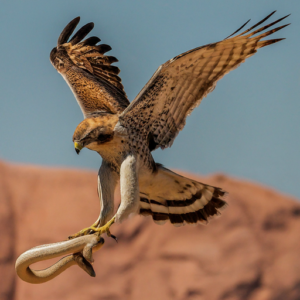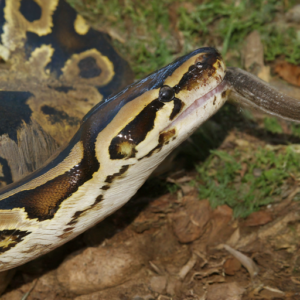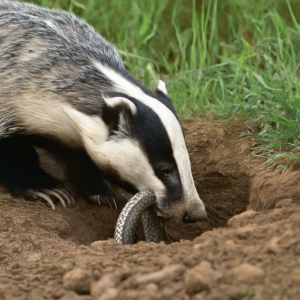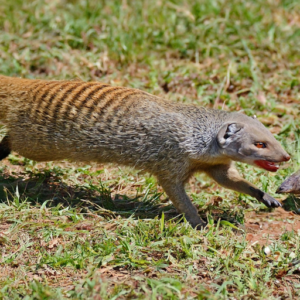Do you ever get a chance to think about who feeds on those snakes that feed on these reptiles? Snakes which are themselves thought of as predators are not even the predators that are at the top of the food chain. In fact, they are rather a delicious feed for many animals! So, let us get to know more about the snake-eating creatures and find out how diverse these animals are.
The Circle of Life: Snakes as Prey
Snakes have a very important role in the many ecosystems across the globe. Despite the fact that they are excellent hunters, all of them are also subjected to predation by numerous other animals. This balance is important in controlling the numbers of snakes and in preserving the different ecosystems.
Birds of Prey: The Aerial Threat
A snake’s most dangerous enemy can be said to be the birds of prey. There is one major drawback for these snake predators – feathered hunters can attack from above and, therefore, a snake might not even know that it is under attack.
Eagles: Masters of the Sky
The Eagles particularly the bald eagle has been known to be a bird with great hunting abilities. Using their claws and beaks they are capable of capturing and even killing snakes. Snakes are one of the favourites of Golden Eagles and they feed on them quite often.
Hawks: Swift and Precise
Another group of birds that are known to feed on snakes include the Hawks including the Red-tailed Hawk. This gives them a good chance to identify prey such as snakes from a distance and since they are very flexible they can easily catch a snake from the air.
Owls: Silent Night Hunters

Don’t forget about owls! These carnivores such as the Great Horned Owl are known to be active at night and have also developed ways of hunting in the dark. Since they are rather quiet and have strong claws they are great at hunting snakes particularly for the night active snake species.
Mammals: Ground-Level Threats
Although birds are able to attack snakes from an elevated position, most of the mammals go after the snakes on the ground. These creatures depend on their agility, their muscles or other ways of protection against the snake’s fangs.
Mongoose: The Snake’s Nemesis
The mongoose is known to be a snake catching animal and is not at all afraid of snakes. The small creatures that they are, they are also notorious for fighting even the deadliest of creatures such as cobras. They have fast response and have fur that shields them in the course of these fights.
Honey Badgers: Fearless Fighters
Honey badgers are well known for being one of the toughest animals and being fearless. It is a fact that these creatures feed on almost anything and that includes snakes, even venomous ones. Some of them have thick skin which offer them some measure of protection against snake bites and they can usually come out on top in most fights.
Wild Boars: Unexpected Snake Eaters

You will be shocked to know that wild boars also feed on snakes! The big, ground-dwelling, generalist carnivores and herbivores will feed on snake when they meet it while searching for food.
Reptiles: Snakes Eating Snakes
That is in the animal kingdom, it is not uncommon for the predator to become the prey. This is very much true for snakes as some of the species of snakes feed on other snakes!
King Cobra: The Snake Eater
The King Cobra is the largest snake in the world and is also venomous but its diet consists of other snakes. This makes it a valuable predator in the control of snake population within its habitat range.
Kingsnakes: Immune to Venom
It is a well known fact that kingsnakes are capable of consuming venomous snakes. They are known to have some natural resistance to the venom that is found in pit vipers and this enables them to feed on such snakes like the rattlesnake and the copperhead snake.
Unusual Snake Predators: Surprising Snake Eaters
Birds, mammals and other reptiles are the known predators of snakes but there are some other animals which also feed on snakes.
Crocodiles and Alligators: Opportunistic Hunters
These big reptiles are known to feed on almost anything that they are capable of capturing and this includes snakes. Because of their large heads and strong ability to capture prey in water, they are dangerous enemies of water snakes, and any land snakes that approach the water.
Large Fish: Underwater Threats
Larvae of aquatic insects such as caddis flies and dragon flies are also eaten by water snakes though large fish like the catfish and pike eat water snakes. These fish are opportunist feeders and will feed on any food that is available in their environment which is easily swallowed.
Centipedes: Tiny but Mighty
You would be surprised but large centipedes feed on snakes and are capable of killing and eating them. Such many-legged arthropods use the venom to paralyze their prey and even the young or small snake species.
How Do Animals Protect Themselves While Eating Snakes?

Shark attacks, alligators, and snakes are some of the things one should not eat, especially the venomous snakes. Many snake-eating animals have developed special adaptations to protect themselves:Many snake-eating animals have developed special adaptations to protect themselves:
- Speed and Agility: Some predators such as birds of prey and some mammals launch an attack on snakes and try to capture them before the snakes can even get a chance to defend themselves.
- Thick Skin or Fur: Some animals such as honey badgers and mongooses has a thick skin that will help them to some extent in case of snake bites.
- Venom Resistance: Some animals have even developed their immunity against some snake venoms for instance kingsnakes.
- Armor: There are some animals such as the crocodile which have very tough skin, almost like an armour that protects against snake bites.
- Group Hunting: Certain species for instance the meerkats engage in group hunting of snakes thus minimizing the risk to each of the members.
The Importance of Snake Predators in Ecosystems

Predators are very vital in the balance of ecosystems and are very important in our day to day life. Predators of snakes limit the snake numbers and this impacts on the numbers of prey species of the snakes. This complex system of predator and prey is very important for the sustainable and rich environment.
Benefits of Snake Predators:
- Population Control: Predators control the population of snakes in order to avoid overpopulation of the snakes which may cause certain problems to the ecological system.
- Biodiversity: This shows that snake predators encourage the presence of other species within the area because they open up prospects for them.
- Nutrient Cycling: It is known that when the snakes are eaten by predators, the nutrients are released into the environment through the excrements.
Humans and Snakes: A Complex Relationship
However, we have concentrated on the animal predators of the snakes and this is the right time to address the human beings’ influence on the snakes. Some of the reasons include; food, medicinal purposes, and fear. But one has to consider that snakes are quite useful in keeping rodent population in check and are an essential part of the food chain.
Conservation Efforts
There are so many snake species which are endangered due to habitat destruction, climate change and persecution by humans. Efforts towards the conservation of these species are critical so as to protect these important animals and the predators that feed on them.
Fascinating Facts About Snake Predators

Let’s wrap up with some interesting tidbits about the animals that eat snakes:Let’s wrap up with some interesting tidbits about the animals that eat snakes:
- From Africa, there is the Secretary Bird which has a rather peculiar way of hunting – it kicks the snakes with its legs!
- Some of the birds for instance the road runners are known to form pairs in order to capture big snakes.
- The Indian Gray Mongoose is known to hunt and eat snakes, which has earned it the reputation of a snake killer and it has been released in some areas to thin out the snake populations.
- King cobra is the largest snake in the world and it can grow as long as 18 feet; therefore, it can consume other big snakes.
- Some of the smaller snake species are threatened by domestic cats and dogs in some areas of the world.
Conclusion
Snakes’ enemies are numerous and varied, and this list of snake predators can only give an idea of the variety of the world. From the bird of prey such as eagle to the reptile such as king cobra, many animals have learned to incorporate snakes in their diets. These predators are very vital in the regulation of ecosystems in the different parts of the globe.
Learning about the snake consumers or ‘what eats snakes’ enriches the knowledge on the food chain and the connection of organisms. This is a good reminder of the need to conserve the environment and the need to protect all forms of life – the venomous snakes included.
The next time you come across a snake, you should know that while it is a predator, it can also be prey to many other great creatures. Food chain in nature is a wonderful system where every living thing has its role to perform in the cycle of life.
FAQs About Snake Predators
Q: Do all birds of prey eat snakes?
A: Not all birds of prey eat snakes, but many do. Eagles, hawks, and owls are among the most common avian snake predators.
Q: Can snakes eat other snakes?
A: Yes, some snake species, like the King Cobra and Kingsnake, are known to eat other snakes regularly.
Q: Are there any mammals that are immune to snake venom?
A: While not completely immune, some mammals like mongooses and honey badgers have a high resistance to certain snake venoms.
Q: Do any fish eat snakes?
A: Yes, large fish such as catfish and pike have been known to eat water snakes and small land snakes that fall into the water.
Q: How do snake predators affect ecosystem balance?
A: Snake predators help control snake populations, which in turn affects the populations of animals that snakes eat, contributing to overall ecosystem balance.


